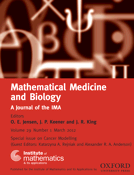-
Views
-
Cite
Cite
Katarzyna A. Rejniak, Vito Quaranta, Alexander R. A. Anderson, Computational investigation of intrinsic and extrinsic mechanisms underlying the formation of carcinoma, Mathematical Medicine and Biology: A Journal of the IMA, Volume 29, Issue 1, March 2012, Pages 67–84, https://doi.org/10.1093/imammb/dqq021
Close - Share Icon Share
Abstract
The disruption of tissue epithelial architecture is thought to be involved in the initiation of cancer; however, little is known about the cell biology of early neoplastic lesions. Computational models can facilitate in the study of early cancer stagesby simulating different scenarios of tumour inception and by testing in silico the influence of various intrinsic and extrinsic factors on the emerging multicellular morphologies. Here, we have used a computational model to create 3D morphocharts, collections of multicellular morphologies arising from systematic modification of three model parameters defining cell sensitivity to external cues for cell growth, death and adhesion to the extracellular matrix. This systematic search revealed the ranges of parameter values for which robust epithelial structures formed and those that led to abnormal geometrical forms resembling tumour-like morphologies. We also showed how our model can be used to map morphologies of experimental multicellular systems onto their in silico counterpart via the cell sensitivity parameter space that may in turn allow us to identify genetic or epigenetic changes responsible for these morphological distortions.





